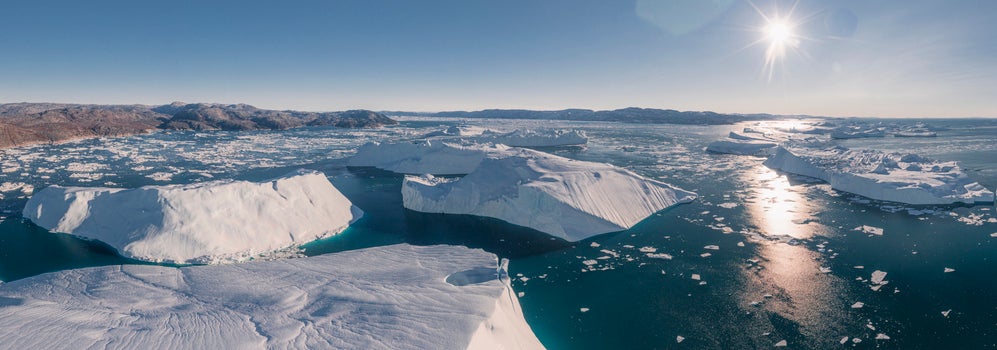
Quick Key Facts
- Temperatures in the Arctic are increasing four times faster than the rest of the planet.
- The main driver of Arctic sea ice decline is human-caused global warming.
- Sea ice reflects about 50 to 70 percent of incoming solar energy, while the much darker surrounding ocean only reflects about six percent.
- Most multiyear sea ice is fresh enough to drink, as the salt drains through the ice leaving fresh water behind, which is often used for polar expeditions.
- The Arctic is the only place polar bears are found on Earth.
- The record low for Arctic sea ice extent — 1.32 million square miles — was set on September 15, 2012.
- The planet loses Arctic sea ice at a rate of nearly 13 percent every ten years.
- In the past three decades, the thickest and oldest Arctic ice has declined by 95 percent.
What Is Arctic Sea Ice?
Sea ice forms and covers most of the Arctic Ocean during the shorter, darker winter months. How much of the ocean’s surface is covered in sea ice is an important indicator of climate change. By mid-September, after the summer melt, the area covered by Arctic sea ice will have reached its thinnest — about half the maximum area covered in winter.
In the polar regions, the sun’s rays strike the surface of the Earth at an angle that is more grazing than the more direct angle experienced in regions near the equator. This is the primary reason for the cold weather at the poles and the warm weather in equatorial regions.

Sea ice keeps the polar regions cool by reflecting sunlight, as well as by acting as a layer of insulation between the cold air above and the warmer water beneath it. By doing so, sea ice helps to maintain the energy balance of our planet.
As Earth’s temperatures rise, scientists are able to measure the rate at which the warmer air and water temperatures reduce the amount of measurable sea ice. They have found that the maximum amount of sea ice has been shrinking at an alarmingly rapid pace.
Why Is Arctic Sea Ice Important? Why Does It Matter?
Human Impacts
The melting of Arctic sea ice can have enormous impacts on humans. It can lead to extreme weather changes that can cause drought, heat waves, flooding and wildfires, displace people from their homes, increase human-wildlife conflict, disrupt food systems and alter the shipping routes used to transport goods all over the world.
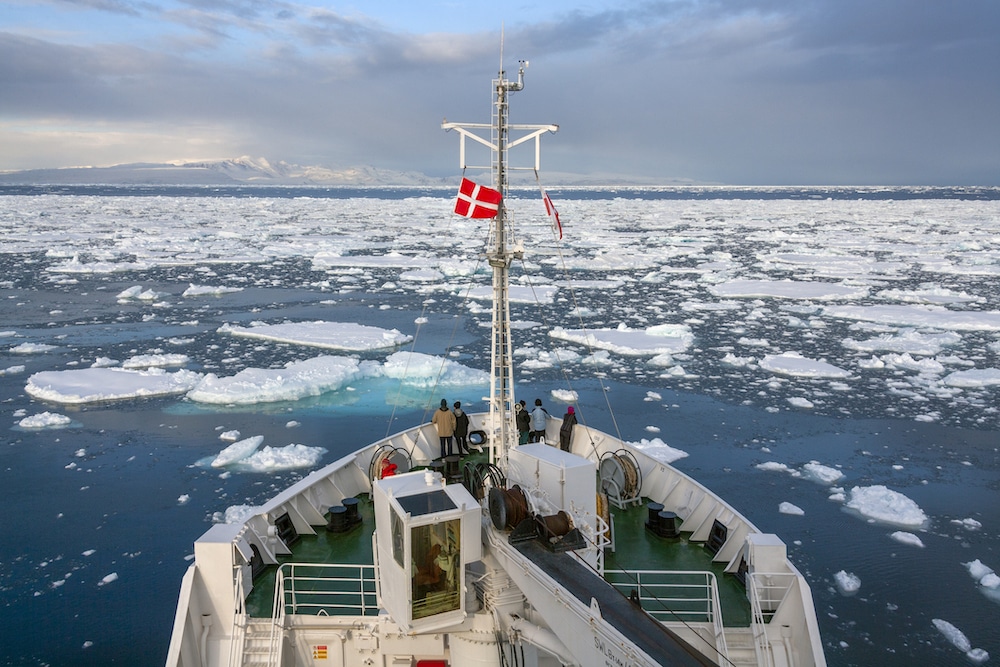
Coastal Communities
Despite what many people may think, the melting of Arctic sea ice does not contribute greatly to sea level rise. This is because it is sea water that has frozen, so, like an ice cube, when it melts it doesn’t change the overall water level.
As Arctic sea ice melts, its coastlines become exposed to the open ocean, making them more vulnerable to larger storm-generated waves. This can lead to accelerated coastal erosion, which impacts the environment, including human and wildlife habitats. The erosion releases soil, salt, nutrients and sediment into the ocean, which can carry pollutants from the land with it. This can cause negative impacts for animals who live on the beach and in coastal waters. Coastal erosion can also damage rail and road transportation infrastructure, and sedimentation changes along coastlines can impact navigation routes.

Unlike the melting of Arctic sea ice, when ice on land from the Antarctic or Greenland ice sheets melts it can contribute significantly to sea level rise. This is because ice that was previously frozen on land makes its way to the ocean, adding to its volume.
The melting of Greenland’s ice sheet contributes to sea level rise at the rate of at least 0.5 millimeters annually, and recent studies suggest the rate may be speeding up. If all the ice on Greenland were to calve into the ocean or melt, sea levels around the world would rise 23.6 feet.
Food Supply
The unpredictability of rapidly changing temperatures and weather patterns — like polar vortexes and heat waves — associated with the loss of Arctic sea ice and the climate crisis can result in damage to crops that supply the world’s food, inevitably harming vulnerable populations the most.
Shipping
The Arctic Ocean is the shortest shipping route between Asia and Europe, but it is usually impassable. However, as Arctic ice melts, new shipping routes are created. During part of the year, some routes have already started to open because of declining sea ice.
These unexplored pathways not only open up possibilities for saving time, but also increase the potential for increased shipwrecks and oil spills in areas that could be difficult for crews to access.
More shipping traffic also means an increase in noise pollution that is stressful to wildlife, as well as increased debris that presents hazards for migratory animals like whales.
Salinity
As ice forms, it becomes less salty as the freezing process expels salt into the surrounding water. The older the ice is, the fresher it is on the surface. When pools of melted water form on multiyear ice, it can be fresh enough to drink.
Since it is less dense, fresh water tends to stay on the surface of the ocean. This lower density water failing to sink at the poles influences ocean circulation, making it more difficult to move warm water northward from the equator. Stagnation can result, affecting the planet’s climate.
Permafrost
Arctic ice and the thick, permanently frozen subsurface layer of soil known as permafrost — made up mostly of plant material in the soil, called “organic carbon” — store large amounts of greenhouse gases like methane and carbon dioxide, major contributors to climate change.
As permafrost thaws and these greenhouse gases are released, the rate of planetary warming increases. As Earth’s temperatures rise further, more permafrost and ice thaw or melt, releasing even more greenhouse gases, and the cycle continues at an even greater pace.
Biodiversity Impacts
For some animals, like Arctic foxes, polar bears, snowy owls, walruses, caribou and other species, sea ice is the only home they’ve ever known. As the ice shrinks, so does their habitat, and they must adapt quickly to survive.
As Arctic sea ice disappears, it brings humans and wildlife into more frequent contact as animals wander into Arctic communities searching for sustenance and refuge as their natural habitat melts away.

Benefits of Arctic Sea Ice
Cools the Planet
The Arctic and Antarctic act as the planet’s cooling system. Ice and snow reflect about 80 percent of the sun’s rays back into space, maintaining the extreme low temperatures of the region and balancing out hotter parts of the planet that absorb heat from the sun.
The less ice there is, the less it is able to act as a reflector, which increases the chance of more global heat waves. The more of the ocean that is exposed, the more its darker waters can absorb solar energy, which leads to higher temperatures and a cycle of warming and melting. It can also result in more extreme winter temperatures, since warmer air destabilizes the polar jet stream, bringing cold air further south.
Insulates
Sea ice forms an insulating barrier, separating the cold air in the atmosphere above from the warmer ocean waters below. This “blanket” keeps both the warm and cold air where they should be, helping to maintain Earth’s energy balance and prevent atmospheric warming.
Heat can escape from the ocean through thin ice or fractures, called leads. About half of the exchange of heat between the Arctic Ocean waters and the atmosphere is due to warm air escaping through openings in the ice cover.
The thinner the ice and the more leads the sea ice has, the less effectively it can provide insulation between the ocean and the atmosphere. This causes the Arctic atmosphere to warm, which affects global atmospheric circulation and weather.
In a process called thermohaline circulation — known as the Great Ocean Conveyor Belt — heat is transported from the equator to the poles. As warm water moves north, it cools, becoming heavier and more dense, which causes it to sink. The water then moves south before rising near the equator, completing the cycle. This natural process helps to balance out Earth’s temperatures. For instance, it keeps Europe relatively warm for its latitude.
Provides Vital Habitat
Arctic sea ice is home to many types of animals, inducing polar bears and narwhals. The ice provides a birthing and resting place for walruses and seals, a place for polar bears to breed and a foraging ground for Arctic foxes, caribou and other mammals. As sea ice melts, so do habitats, and a lack of sea ice can lead to extinction for some species, as they are unable to hunt and reproduce effectively.
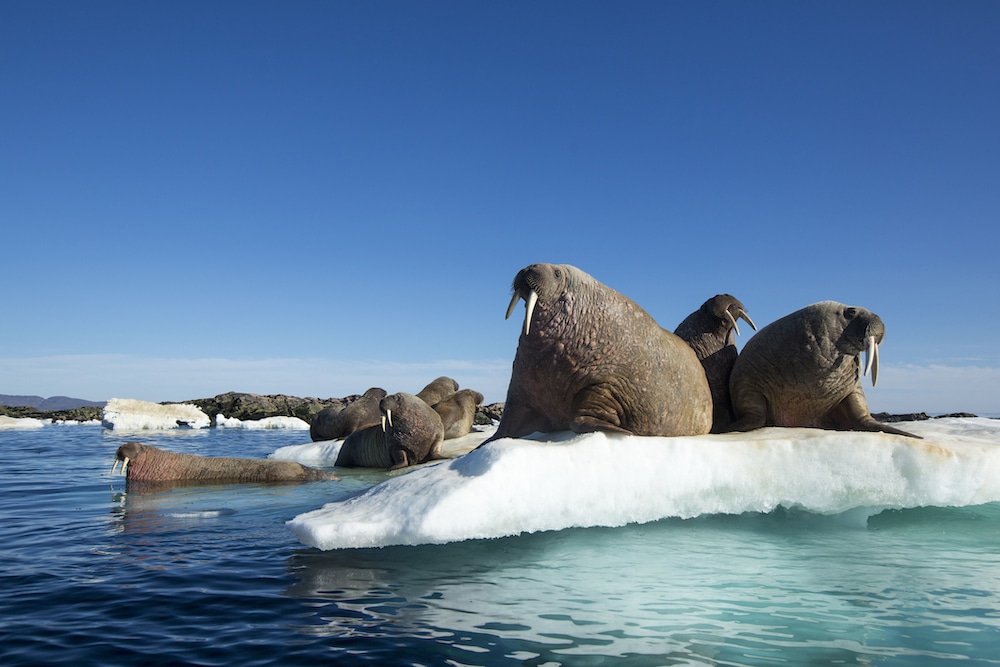
If the ice pack shrinks past the edge of the continental shelf — where walruses usually feed — they are forced to swim as much as 250 miles round trip to their feeding grounds, or otherwise crowd together onto small islands or shores.
When Arctic foxes aren’t able to migrate onto the ice, they can become stranded onshore with predators. And some migrating caribou have fallen through ice that was thinner than usual.
Some species of seal are so linked to the ice that their entire existence depends on it. Harp seals live on the edge of sea ice year-round, migrating south in the spring to follow it. Since the beginning of the satellite record, sea ice cover in harp seal breeding habitat has declined. Ringed seals give birth on the ice, which must be sufficient and stable enough for them to build birth lairs and rear their pups. A decrease in sea ice extent reduces seal habitat, and an early breaking up of the ice could mean premature separation of mothers from their pups.
Polar Bears
Polar bears are found in only one place on the planet — the Arctic — where they are apex predators and the largest land carnivore.
For polar bears, thick, stable ice that has been building up for years is the preferred habitat for hunting their main food source: bearded and ringed seals. They eat very little in the summer months while they wait for the ocean waters to freeze again. In some areas, like Hudson Bay, all the bears come ashore during the summer and early fall.
Polar bears can swim, but they don’t often swim too far from land, so lack of sea ice cover means they are forced to swim distances between the edge of the pack ice and land that can sometimes prove too far.

Phytoplankton
The cycle of melting and freezing water in the Arctic keeps the life there healthy, from phytoplankton — an essential food source for marine creatures — to whales.
When ice crystals form on the surface of the ocean, they expel salt that sinks to the bottom. In other parts of the ocean, waters rise, bringing forth nutrients essential to the phytoplankton. When this melt-freeze cycle is disrupted, so is the sustenance of many ocean animals.
Indigenous Peoples
For millennia, the Arctic has been home to populations of Indigenous Peoples — currently about one million — many of whom live along the region’s coasts. For many of these communities, the sea ice is the coastline’s protector from strong winter storms, and an extension of the land used for travel and hunting, as well as to access fish, seals, walruses, whales and other marine life. If sea ice melts too fast in the spring, it leads to a shorter hunting season.
For Indigenous populations, shrinking sea ice means the loss of their homeland. It also affects weather patterns, animal migrations and causes other environmental shifts — patterns that are the bases of their livelihoods and culture.
Less sea ice means fewer animals migrating to Indigenous areas, which means Indigenous Peoples must alter ancient hunting practices. Thinning ice also means more cracks, causing safety concerns. Weather could once be predicted through observations of natural patterns, but now it shifts so quickly and those methods are not always as reliable as they once were.
Since the Indigenous Peoples of the Arctic have such intricate knowledge of sea ice — some of which is passed down through songs and stories — they can provide local observations and fill in missing information and knowledge that can be important to ongoing research on how the region is being altered by climate change. In fact, Bering Sea Elders authored a chapter of the Arctic Report Card for the first time in 2019.
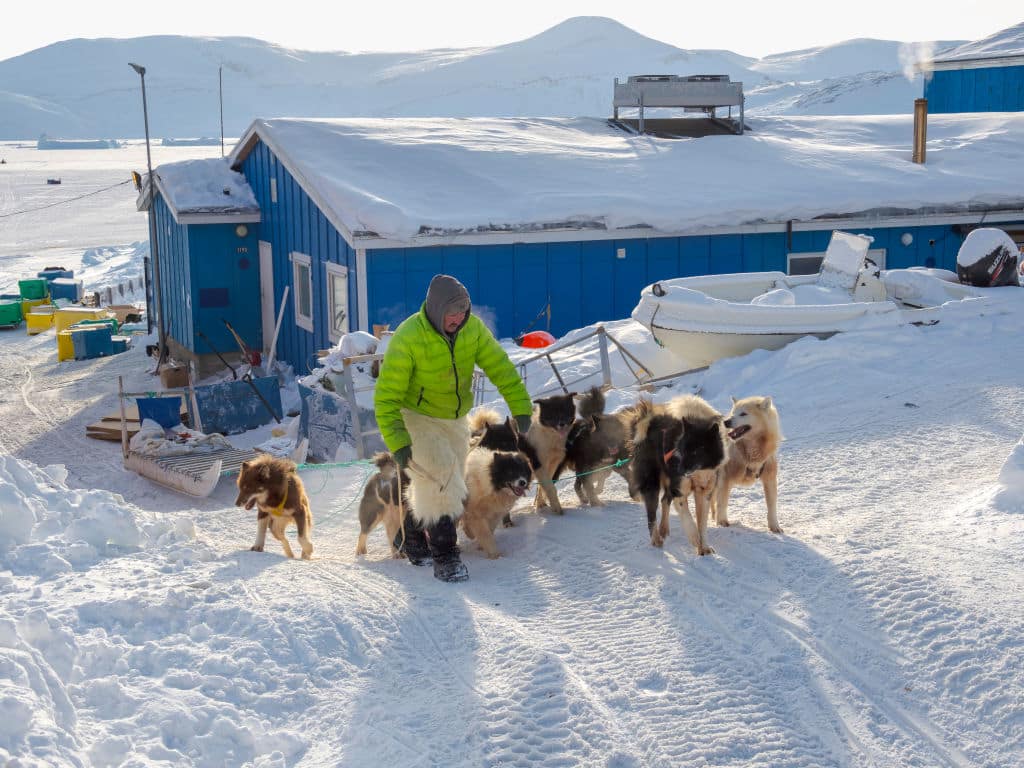
Threats to Arctic Sea Ice
Climate Change
The main cause of Arctic sea ice decline is human-caused global warming. Human activities such as the burning of fossil fuels and industrial agriculture increase emissions of greenhouse gases like carbon dioxide and methane that trap heat in the atmosphere, causing Earth’s temperatures to rise. Temperatures in the Arctic are increasing at four times the rate of the rest of the planet — a phenomenon known as Arctic amplification. Methane is the second most prevalent greenhouse gas and a major cause of Arctic amplification. Methane traps heat in the planet’s lower atmosphere at about 25 times the rate of carbon dioxide.
Until we curb our use of fossil fuels and revert to more regenerative livestock and farming practices, global warming and its consequences will continue.
Sea ice extent has been declining every decade since satellites started monitoring sea ice conditions almost continuously in November 1978. The smallest declines are seen in April, while the largest declines occur in September.
The record low for Arctic sea ice extent is 1.32 million square miles, set on September 15, 2012.
Newly formed sea ice can be extremely thin, but over time it thickens and becomes multiyear ice about 12 to 15 feet thick. Since the 1950s, however, Arctic sea ice has been getting thinner and younger.
A study found that 35 percent of the ice pack in the Arctic in 1987 was a minimum of four years old, with one-fourth of that ice being at least nine years old. But by 2020, almost none of the ice was a minimum of nine years old and less than five percent was at least five years old.
Now, more and more ice is first-year ice about three to six feet thick, as multiyear sea ice keeps declining.

Arctic Amplification
The poles are the most sensitive regions to climate change on Earth, so even a small increase in the average temperature of our planet can lead to greater warming over time.
Arctic amplification is the increasingly sped-up level of warming that is taking place in the Arctic compared to the rest of the world. It operates as a feedback loop: The warmer it gets the worse the amplification gets, which leads to more ice melt and further amplification. In turn, this cycle leads to accelerated climate change for the rest of the planet.
New research has suggested that sea ice melt is the factor most contributing to Arctic amplification.
As permafrost in the Arctic thaws and dries out, grasslands become more susceptible to wildfires, which cause more greenhouse gases to be released into the atmosphere.
At midlatitudes, soot or “black carbon” from wildfires can travel through the atmosphere and land on sea ice, darkening it and speeding up its melt. A 2021 study found that wildfires may be sending three times more black carbon to the Arctic than had been predicted by climate models.
Industrialization and Oil and Gas Activities
Oil and gas activities in the Arctic like the recently approved ConocoPhillips’ Willow project continue the extraction of fossil fuels at a time when the climate-warming emissions they produce — which are ultimately causing the melting of Arctic sea ice — should be reduced and eliminated.
The new shipping routes created by the melting of sea ice also make the region more accessible for fossil fuel energy firms.
Fossil fuel activities wreak havoc on the Arctic ecosystem, disrupting Indigenous communities and the daily lives and migratory patterns of native wildlife. These enormous projects decimate habitat and put local inhabitants at risk from the devastating consequences of oil spills, which are far too common in what would otherwise be pristine wilderness.
More than two dozen oil fields litter Alaska’s North Slope, including Prudhoe Bay, the largest oil extraction project in Alaska thus far. In operation since 1977, Prudhoe Bay is about 250 times as large as Central Park in New York City.
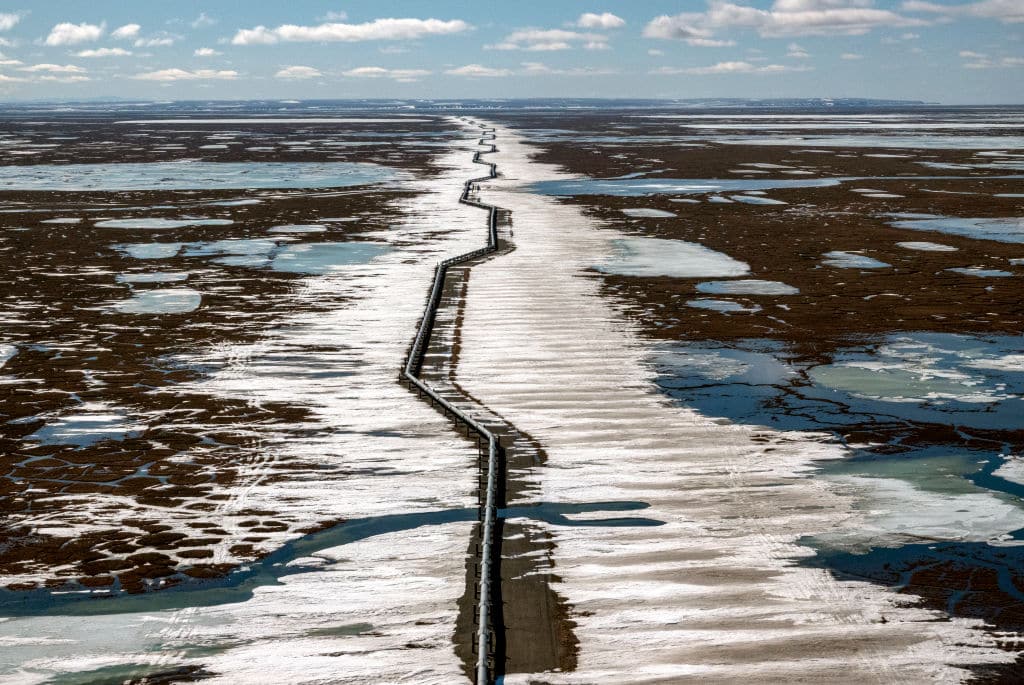
The Alaska Department of Environmental Conservation has said that, since 1996, the oil fields of Prudhoe Bay and the Trans-Alaska Pipeline have averaged 500-plus oil spills per year on the North Slope.
In addition to oil and gas projects, other forms of industrialization plague the Arctic. Factories dot the coastline of Russian Siberia, where toxic pollutants sink into the local environment and are trapped by sea ice, which circulates them throughout the region.
Microplastics from the breakdown of industrial waste and consumer products can be found throughout the Arctic sea ice and seawater below. These tiny plastic particles can come from fishing gear and other human-generated sources.
What Can We Do to Support Arctic Sea Ice?
As a Society?
The best thing humans can do to support Arctic sea ice is to reduce, and eliminate as quickly as possible, the use of fossil fuels and replace them with renewable energy sources. We must do this in order to limit global heating to a maximum of 2.7 degrees Fahrenheit to prevent the worst effects of climate change.
We must also eliminate industrial agriculture and factory farming operations and replace them with sustainable, regenerative agricultural practices on smaller, organic farms.
In the meantime, helping wildlife, ecosystems and communities adapt to the changes we’re already experiencing is also important.
In Our Own Lives?
Reducing our own carbon footprint by driving less, opting for renewable power sources, buying local and organic produce, growing our own fruits and vegetables using regenerative practices, eating less meat, helping our communities start gardens and participating in groups interested in coming up with ways to make our communities greener are all ways to help curb global warming and support Arctic sea ice.
We can vote for leaders who are willing to put policies into practice that will help us make the fastest transition to renewable energy. We can also support businesses that are working to reduce their carbon footprints, and not patronize those that have ties to fossil fuel interests.
Takeaway
Rising temperatures in the Arctic and the shrinking of sea ice maximum extent are indicators of the progress of climate change. Temperatures in this unique ecosystem are heating up nearly four times faster than on the rest of the planet, which means time is of the essence when it comes to slowing global heating, by curbing our use of fossil fuels and our reliance on industrial agriculture in order to avoid the worst effects of climate change.
If emissions continue to rise unabated, there could be no ice left during Arctic summers by 2040. We must act now before it’s too late to stop the feedback loop of Arctic amplification and sea ice melt from destroying our planet’s natural cooling system.

The post Arctic Sea Ice 101: Everything You Need to Know appeared first on EcoWatch.
